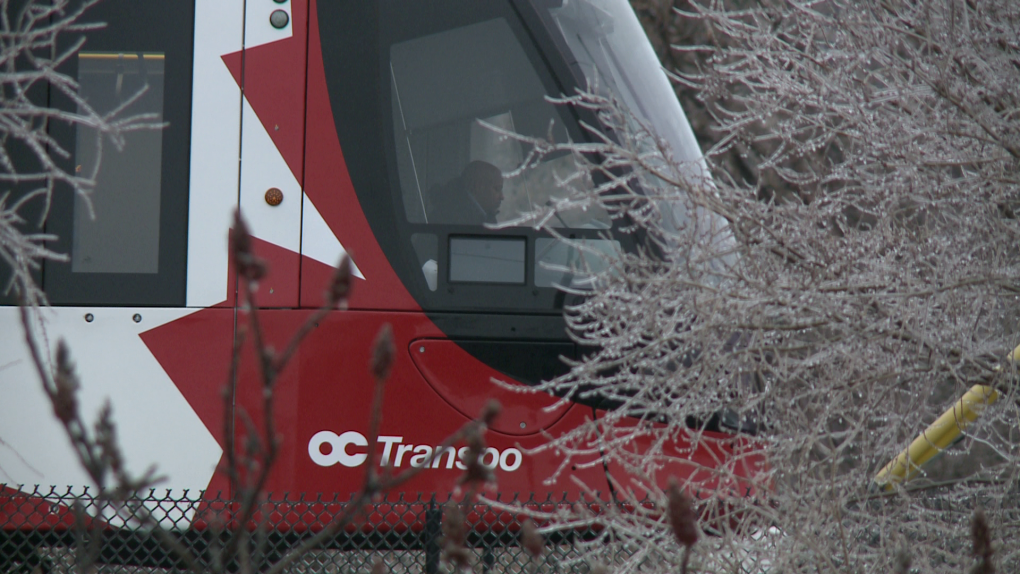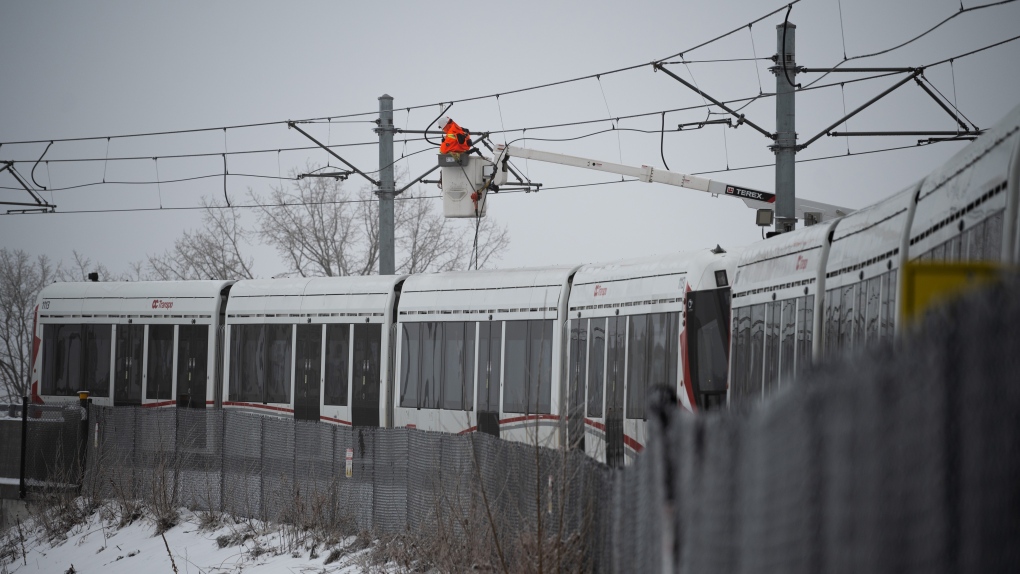Officials blame Ottawa LRT shutdown on 'unique' ice buildup
More than a month since a section of Ottawa’s LRT system shut down for six days after a freezing rainstorm, officials have revealed the cause of the outage.
The short answer: it was ice.
But how the ice got there, officials said, was due to a “unique combination of factors.”
Those factors led to two trains on the Confederation Line, one eastbound and one westbound, getting stuck near Hurdman Station. Two trains later sent to help also got stuck.
The city and its LRT contractor Rideau Transit Maintenance said they are exploring several options—from anti-icing treatments to a rescue diesel train—to stop a similar outage from happening again.
It is not clear why, after four years of operating the system, some of the ice mitigation strategies have not been put in place.
‘Unique’ weather conditions
The city’s transit commission heard details for the first time on Thursday about what exactly led to the shutdown in early January.
The six-day shutdown happened when some freezing rain caused buildup on the overhead wire that powers the trains between Hurdman and Lees stations. Service still ran on parts of the line farther east and west.
 A stopped LRT train just east of Hurdman Station on Thursday, Jan. 5, 2023. (Jim O'Grady/CTV News Ottawa)
A stopped LRT train just east of Hurdman Station on Thursday, Jan. 5, 2023. (Jim O'Grady/CTV News Ottawa)
Richard Holder, the city’s director of engineering, said specific conditions at the time led to more ice buildup on the wires than usual.
The Rideau River was ice-free due to a warmer-than-usual start to January, he said. That led to high levels of humidity in the area, which led to further accumulation on top of the freezing rain. This all led to ice quickly building up on the overhead catenary wire that powers the trains, he said.
“This unique combination of factors caused greater ice building in that area than elsewhere on the system,” Holder said. “We’re very certain that this occurred because of the accumulated ice on the OCS contact wire.”
Contact wire ‘melted’
When recovery trains were dispatched later, they were forced to go slowly, which resulted in a lot of electrical arcing on a small section of the contact wire.
“Normally when a vehicle is moving fast and you get arcing, the arcing event is spread out over a larger area, with the vehicles basically stationary that arcing all occurred in the same section, creating a huge amount of energy, a huge amount of heat generated,” he said.
“The contact wires basically melted,” Holder said.
Crews then had to spent several days clearing ice off the wires and then fixing the wires. They broke ice by hand off about 5.6 kilometres of the line, from uOttawa station all the way to Tremblay station.
 A worker repairs overhead wires on a stalled LRT OC Transpo train near Lees Ave., station in Ottawa, on Friday, Jan. 6, 2023. According to city officials freezing rain partially shut down train service between a number of station in the city’s east-end damaging overhead wires. (Spencer Colby/THE CANADIAN PRESS)
A worker repairs overhead wires on a stalled LRT OC Transpo train near Lees Ave., station in Ottawa, on Friday, Jan. 6, 2023. According to city officials freezing rain partially shut down train service between a number of station in the city’s east-end damaging overhead wires. (Spencer Colby/THE CANADIAN PRESS)
“That breaking of the ice, and when I say by hand, it is literally somebody in a high-rail vehicle on a bucket breaking the ice off by hand,” he said.
And while repairing the wires only took a few hours, he said a full inspection of the system took several days.
City looking into diesel rescue train
The city and Rideau Transit Maintenance have established a working group on the overhead wires.
Certain changes have already been made. The city is installing winter carbons on light rail vehicles, Holder said.
“Those are a brass insert installed into the pantograph, which have a more aggressive metal edge and are able to break through and shear off the ice accumulation,” he said.
OC Transpo will also “strategically” place staff on the line for monitoring ice buildup and arcing, he said. And a new onboard train diagnostic system will give advance warning for issues happening with the vehicle, such as voltage drops.
Down the line, the city is also investigating use of anti-icing treatments to be used on the contact wires in advance of freezing rain, Holder said. The Toronto Transit Commission uses such a system.
“They have a pretty extensive program for their trams where they have vehicles out on the street continually spraying anti-freezing agents onto the OCS,” he said.
They are also looking at procuring a diesel recovery train, which wouldn’t be affected by problems with the overhead wire.
“I’m kind of shocked we don’t have one of those yet,” Coun. Tim Tierney told transit commission.
RTM head Mario Guerra said they are already looking for such a vehicle.
“You can appreciate our system is unique in terms of the envelope, so it’s going to prove difficult to get something off the shelf that would fit into our system,” he said. “But we also have some equipment here that we think we might be able to alter for that purpose.”
CTVNews.ca Top Stories

'Anything to win': Trudeau says as Poilievre defends meeting protesters
Prime Minister Justin Trudeau is accusing Conservative Leader Pierre Poilievre of welcoming 'the support of conspiracy theorists and extremists,' after the Conservative leader was photographed meeting with protesters, which his office has defended.
What is changing about Canada's capital gains tax and how does it impact me?
The federal government's proposed change to capital gains taxation is expected to increase taxes on investments and mainly affect wealthy Canadians and businesses. Here's what you need to know about the move.
'My stomach dropped': Winnipeg man speaks out after being criminally harassed following single online date
A Winnipeg man said a single date gone wrong led to years of criminal harassment, false arrests, stress and depression.
Bank of Canada officials split on when to start cutting interest rates
Members of the Bank of Canada's governing council were split on how long the central bank should wait before it starts cutting interest rates when they met earlier this month.
Pilot reported fire onboard plane carrying fuel, attempted to return to Fairbanks just before crash
One of the two pilots aboard an airplane carrying fuel reported there was a fire on the airplane shortly before it crashed and burned outside Fairbanks, killing both people on board, a federal aviation official said Wednesday.
'One of the single most terrifying things ever': Ontario couple among passengers on sinking tour boat in Dominican Republic
A Toronto couple are speaking out about their 'extremely dangerous' experience on board a sinking tour boat in the Dominican Republic last week.
Quebec nurse had to clean up after husband's death in Montreal hospital
On a night she should have been mourning, a nurse from Quebec's Laurentians region says she was forced to clean up her husband after he died at a hospital in Montreal.
7 surveillance videos linked to extortions of South Asian home builders in Edmonton released
The Edmonton Police Service has released a number of surveillance videos related to a series of extortion cases in the city now dubbed 'Project Gaslight.'
Ukraine uses long-range missiles secretly provided by U.S. to hit Russian-held areas, officials say
Ukraine for the first time has begun using long-range ballistic missiles provided secretly by the United States, bombing a Russian military airfield in Crimea last week and Russian forces in another occupied area overnight, American officials said Wednesday.

































